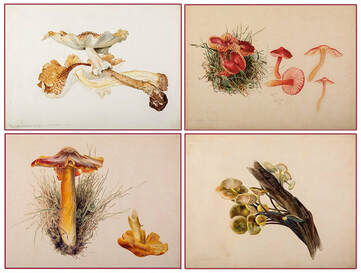|
Joan M. Rehlin
Our mini art history post highlights Helen Beatrix Potter (7/28/1866–12/22/1943) who was not only a well-known English writer of children’s books, but also an accomplished illustrator, natural scientist, and conservationist. Born in London to upper-class parents, Potter spent a privileged but isolated childhood. She was taught at home by a series of governesses, and spent family holidays in Scotland and in England’s Lake District where she developed a love of plants and animals. During childhood, she and her brother Bertram kept numerous small animals as pets — mice, rabbits, a hedgehog, and some bats — which they observed closely and drew endlessly. Potter’s artistic and literary talents were also influenced by her fascination with fantasy books and fairy tales. And as a teenager, she visited numerous London art galleries. Although Potter was aware of artistic trends, her style was uniquely her own. Potter often wrote letters that included sketches of animals and landscapes. She was eventually encouraged by Annie Moore, one of her governesses, to create children’s books when she wrote an illustrated letter to Moore’s son about four little rabbits whose names were “Flopsy, Mopsy, Cottontail, and Peter.” This, of course, evolved into The Tale of Peter Rabbit, one of the most famous children's stories ever written. Potter initially self-published it in 1901. When it sold out, it was published the following year by Frederick Warne & Co. Gaining immediate success, Potter went on to write, as well as illustrate, 22 additional Tales plus several other books. She was also an astute businesswoman who made and patented a Peter Rabbit doll shortly after the book was published, along with other spin-off merchandise including figurines, wallpaper, painting books, and porcelain tea sets. Potter’s popularity was based on her imaginative illustrations of animals in nature, but her legacy isn’t just her substantial contribution to the world of children’s literature. The fortune she subsequently amassed allowed her to purchase parcels of land — generally not an option to 19th century British women — to help preserve the beautiful English Lake District. Upon her death in 1943, Potter bequeathed her land holdings to the National Trust, and those became a sizable portion of what is now the Lake District National Park. In 2016, on the 150th anniversary of Potter’s birth, Chronicle Books commented that she was “far more than a 19th-century weekend painter. She was an artist of astonishing range.” Rather than showcasing one of her children’s book illustrations, we’re including several of the fungi paintings, which Potter created as a young woman, to exemplify the extent of her talent. These intricate watercolor specimens, which gained her respect in the field of mycology, are currently at the Armitt Museum and Library, Cumbria County in the Lake District. Composite of fungi watercolors, c. late 1890s, by Beatrix Potter (clockwise, top left): Lepiota friesii, Hygrocybe coccinea, Flammulina velutipes, and Hygrophorus puniceus
0 Comments
Leave a Reply. |
ART BLOGWelcome to our Art Blog where we occasionally present topics of interest in the fine art world, including featuring artists other than Jim Rehlin. Some of the artwork has been created by long-departed but well-known greats; some, by compelling contemporary artists. All will be pieces we find worthwhile to share with you. If you like any of these, consider sharing the posts forward to your own blogs and other social media. |
|
Artwork by Jim Rehlin.
Website content and modifications ©2024 Rehlin Graphics / Fine Art. All rights reserved. Click HERE to Visit and Like Rehlin Graphics / Fine Art on Facebook. THANKS! |

 RSS Feed
RSS Feed
